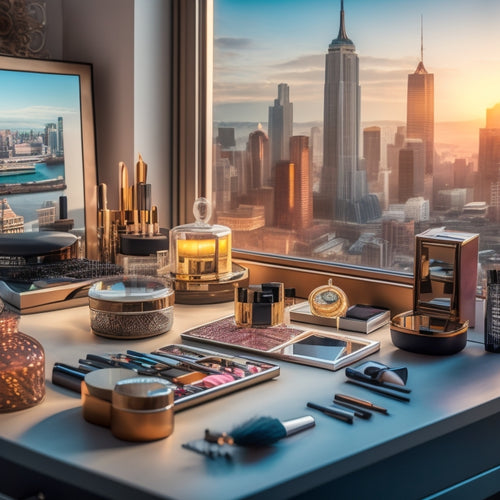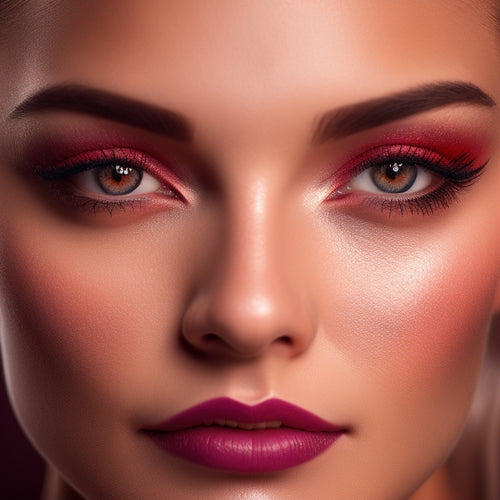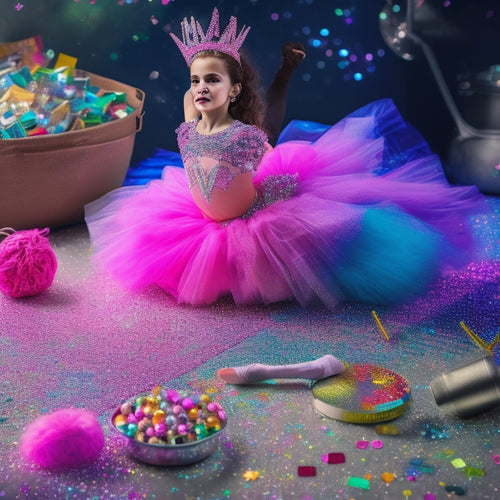
Mastering Dance Makeup: Tips From Pros
Share
Mastering dance makeup necessitates a professional touch to enhance a dancer's features, complement their costume, and transform their stage presence. A polished, stage-ready appearance is guaranteed by professional makeup artists who offer guidance on color matching, selecting complementary eyeshadow hues, and proper application techniques. To achieve a cohesive appearance, it is vital to choose blush shades that complement the natural complexion and costume, and select eyeshadow tones that blend well with the skin tone and costume. By grasping the nuances of makeup design, dancers can reveal a transformative look that highlights their facial expressions and brings their character to life, and there's more to explore about the art of dance makeup.
Key Takeaways
• Professional makeup artists ensure a polished, stage-ready look by providing guidance on color matching and proper application techniques.
• Choose blush colors that complement your natural complexion and costume, considering soft pink for fair skin and deep plum for dark skin.
• Select eyeshadow colors that harmonize with your skin tone and costume, using neutral shades like brown for a versatile look.
• Decide between false eyelashes for a dramatic look and mascara for a subtle enhancement, mastering eyelash application techniques for a polished finish.
• A well-designed makeup look can transform a dancer's features, bringing their character to life and accentuating facial expressions on stage.
Getting Pro Help Matters
Working with a professional makeup artist is crucial for achieving a polished, stage-ready look that complements the dance costume and enhances the performer's natural features. These experts provide invaluable guidance on color matching for foundation, blush, and powder, guaranteeing a seamless blend with the skin tone. They also offer insights on selecting the right eyeshadow colors that harmonize with the costume.
Additionally, professional assistance ensures proper application techniques are learned, including the use of suitable application brushes for different products. By collaborating with a makeup artist, dancers can master the art of makeup and confidently take the stage, knowing their look is both technically sound and aesthetically pleasing.
Blush Selection Essentials
Selecting a blush color that harmoniously complements the natural complexion and costume is vital for creating a cohesive, polished look on stage. In order to achieve this, it's important to take into account natural tones and color matching. A professional makeup artist can help determine the perfect shade, but here are some general guidelines:
| Skin Tone | Blush Color |
|---|---|
| Fair | Soft pink, peach |
| Medium | Coral, salmon |
| Dark | Deep plum, berry |
When choosing a blush, look for shades that blend seamlessly with your skin tone. Avoid strong contrasts, as they can detract from the overall aesthetic. Quality brushes are also necessary for precise and flawless application. By selecting the right blush color and using the correct techniques, you can enhance your natural features and create a stunning stage presence.
Eyeshadow Color Secrets
In dance makeup, the art of choosing eyeshadow colors that complement the costume and skin tone is vital for creating a cohesive, polished look on stage. By understanding color theory, dancers can select eyeshadows that harmonize with their skin tone and costume.
Neutral shades of brown are often a safe choice, as they complement most costumes and skin tones. However, it's essential to avoid colors that clash with the skin tone or costume. Costume coordination is key; for instance, if the costume features bold colors, opt for softer, more muted eyeshadow shades.
Lashes or Mascara: Choose Wisely
When it comes to amplifying the eyes in dance makeup, the choice between false eyelashes and mascara depends on the desired level of drama, individual preferences, and the specific requirements of the performance. False eyelashes provide a fuller lash effect, are reusable, and offer a more dramatic look than mascara. On the other hand, mascara is a more subtle and convenient option that can still enhance the eyes.
Here are some key considerations to keep in mind:
-
Eyelash application techniques: Mastering the art of applying false eyelashes can elevate your dance makeup look. Consider lash extension options for a more dramatic effect.
-
Mascara alternatives: If you prefer a more natural look, consider using individual lashes or lash clusters to add volume and drama.
-
Enhancing eye makeup: Combine false eyelashes or mascara with other eye makeup techniques, such as highlighting and contouring, to create a show-stopping look.
Makeup Magic on Stage
A dancer's makeup design can make or break their stage presence, as it has the power to transform their features, accentuate their facial expressions, and bring their character to life.
When creating a makeup look for the stage, costume coordination is key. Make sure that the colors and styles chosen complement the costume, rather than clashing with it.
Skin tone suitability is also essential, as the right shades can enhance the dancer's natural features. A professional makeup artist can help achieve this harmony, selecting products that blend seamlessly with the skin tone.
Frequently Asked Questions
How Often Should I Clean My Makeup Brushes to Maintain Hygiene?
To maintain peak hygiene and extend makeup longevity, clean your brushes regularly, ideally every 1-3 weeks, depending on usage, using gentle soap and water, and allow them to air-dry to prevent bacterial growth.
Can I Use Everyday Makeup Products for Dance Performances?
Just as a fine-tuned orchestra requires specialized instruments, dance performances demand stage-specific makeup products that can withstand intense lighting, sweat, and movement, making everyday makeup products incompatible, and highlighting the need for product alternatives designed for stage makeup.
Are There Specific Makeup Looks for Different Dance Genres, Such as Ballet or Hip-Hop?
Different dance genres, such as ballet, hip-hop, and contemporary, often dictate distinct makeup looks, influenced by cultural and historical contexts. Makeup trends in ballet, for instance, tend towards soft, natural hues, while hip-hop often incorporates bold, vibrant colors reflecting urban cultural influences.
How Do I Prevent Makeup From Getting Oily or Smudgy During Performances?
To prevent makeup from getting oily or smudgy during performances, apply a primer to create a smooth canvas, set with a setting spray, and use blotting papers to absorb excess oil; schedule touch-ups as needed to maintain a flawless finish.
Can I Do My Own Makeup for a Dance Performance or Is a Pro Necessary?
While DIY makeup is feasible, a professional's expertise guarantees peak results, especially for high-stakes dance performances. Online makeup tutorials can provide guidance, but a pro's personalized color matching, technique, and product knowledge are often essential for a flawless, stage-ready look.
Related Posts
-

10 Best Time-Saving Hacks for Busy Makeup Artists
You're no stranger to the chaotic world of makeup artistry, where every minute counts. To maximize your time, start b...
-

Long-Lasting Dance Makeup: Tips for a Flawless Finish
To achieve a long-lasting dance makeup look, start by preparing your skin through cleansing, moisturizing, and exfoli...
-

Exclusive Crafting Files: Dance Mom Delight
Dance Mom Delight offers a wide collection of exclusive crafting files, providing users with a diverse range of digit...


